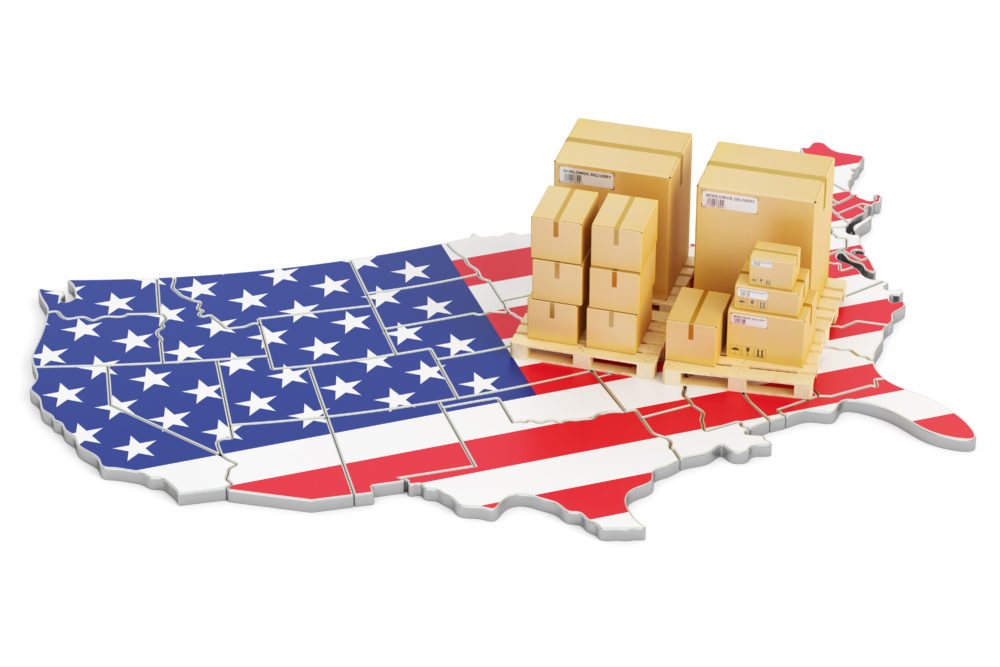There are many reasons that an import from the USA might make good sense for your business. US products are in high demand in the UK while American-made parts are popular when it comes to local product assembly or manufacturing.
The USA is one of the UK’s biggest trading partners, with huge volumes of goods moving between the countries every month. In fact, in 2020, $58.4bn of exports from the US arrived in Britain, somewhere in the region of 4 per cent of all of the exports leaving America.
If you’re thinking of importing from the US to grow your business, there are some things you need to know about the process, and costs involved. Importing can be complex, but don’t panic – this guide is here to help.
How to import from USA to UK
If you’re planning on importing from the USA to the UK, there are a few things you’ll need to prepare in advance, including:
- Commodity codes – used by customs authorities to identify the goods you’re bringing into the country, to ensure the correct tax and duty is paid, and all legal and safety regulations are followed
- Import licence – there are a lot of different types of goods which require an import licence. You’ll definitely need one if you’re importing anything which is hazardous, or could be used for military purposes, and usually if your shipment includes live animals or plants
- EORI number– this is needed by any individual or business importing into the UK. You can get your EORI number within just a few days by registering online with the UK tax authorities
- Customs declaration – if you’re using a customs broker or freight forwarder you might find that they complete some or all of the customs processes on your behalf. You’ll use a form called C88 or SAD – the single administrative document
US to UK import tax
When importing from the US to the UK, you’ll need to pay duty and VAT on your goods. Exactly what you owe will depend on the type of products you’re importing. Because it’s a relatively complex system, many importers prefer to have a freight forwarder or customs broker help them calculate the costs of importing.
>See also: How to import from the EU
Duty on US imports
The duty payable varies depending on the goods you’re bringing into the UK. To know what duty rate is applied, you’ll need to get the commodity code for your goods. You can find these on the UK government website, which has a lookup tool to help you select the correct code.
When you declare your goods to customs in the UK, you’ll be asked to confirm the commodity code, which will be used to calculate the duty payable. Amounts vary quite significantly. If you’re importing women’s cotton shirts from the US, for example, the duty is set at 12 per cent, certain types of new cars come with 10 per cent duty, while some electrical goods may incur a zero rate of duty.
Your goods will be held at UK customs pending payment of duty and VAT. Once this has been paid – either by yourself or a freight forwarder or customs broker on your behalf – they’ll be released.
>See also: Importing from India
Paying VAT on goods from US
As well as duty, you’ll need to pay VAT on items imported to the UK. It’s important to remember that VAT is calculated on the cost of goods + the cost of transport + duty paid. It’s charged at the prevailing UK rate which is currently 20 per cent.
Tip: If you’re buying goods from a supplier in the US, specifically for import to the UK, you should not pay US VAT. VAT will be charged upon import to the UK only. However, if your supplier adds VAT to your US invoice, it can be hard to reclaim it once paid.
Sea or air freight from the US to the UK?
Whether air or sea freight will be your best choice depends largely on what you’re shipping, and when you need it.
Typically, for large volume goods such as clothing or consumer goods, sea freight is a much cheaper option – but this mode of transport takes time.
Air freight is much quicker, but the relative costs are high – it’s a better choice for smaller loads (under about 100kg), high value items, or things needed urgently.
| Sea freight | Air freight | |
| Shipping options | FCL – full container load – in which your shipments takes a whole 20 or 40ft container LCL – less than container load – sharing container space with other shipments Other options available for commodities such as metals, aggregates and dry foodstuffs |
Consolidated freight – consols – where one flight contains many small shipments Direct or charter flights in which a single plane is used for a single shipment – this is a very costly option |
| Costs | Costs calculated based primarily on load volume, with type and value of cargo also considered. Shipping a 40ft container of low value apparel from Florida to London will cost $1400-$1550 |
Costs calculated on load weight and size, with value also considered. Air freighting a 50kg of low value general merchandise from Florida to London will cost $380-$420 |
| Time for delivery | US East Coast – 10 to 14 days on the water US West Coast – 30 days on the water |
Flight time is only a few hours – although consol shipments might take a few days before being assigned a plane |
| Best suited to | Large volume loads, typically over 100kg, where delivery times can be flexible | Small volume, high value or urgent loads |
How to import from the USA
There are a few basic steps you’ll need to take to make sure your goods reach the UK smoothly. In many cases, importers choose to have a freight forwarder or customs broker help with these processes. Although there might be a fee for this service, it can offer peace of mind and help you avoid any delays or nasty surprises.
If you’re planning on importing from the USA to the UK, there are a few things you’ll need to prepare in advance, including:
- Find the right commodity code for your goods. Commodity codes are used by customs authorities to identify the goods you’re bringing into the country, to ensure the correct tax and duty is paid, and all legal and safety regulations are followed
- Get an EORI number – this is needed by any individual or business importing into the UK. You can get your EORI number within just a few days by registering online with the UK tax authorities
- Check if you need an import licence for your goods. There are a lot of different types of goods which require an import licence. You’ll definitely need one if you’re importing anything which is hazardous, or could be used for military purposes, and usually if your shipment includes live animals or plants
- Customs declaration – if you’re using a customs broker or freight forwarder you might find that they complete some or all of the customs processes on your behalf. You’ll use a form called C88 or SAD – the single administrative document
- Pay duty and VAT to have your goods released by customs authorities
>See also: How to import from China to UK
Find the right commodity code
You must find out the relevant UK commodity codes for your items. Commodity Codes are essential to your shipment as if your products are incorrectly labelled it could result in UK Customs delaying or halting your goods.
To find the correct commodity code for the products you need imported from the USA, go to the UK Government Trade Tariff. Here you can look up commodity codes as well as rates for VAT and duty. Commodity codes are vital in classifying your imported goods so that you can:
- Check to see if there are any duty reliefs
- Complete declarations as well as other paperwork
- Find out if you have to pay for any VAT or duty fees
Find out your EORI number
In addition to your commodity code, you will need to obtain an Economic Operator Registration Identification number (EORI).
UK customs uses an EORI number as a means of record keeping for both imported and exported goods. When importing commercial cargo from the USA, all UK businesses are required to have an EORI. This is needed for a commercial invoice if you’re using the CHIEF system (see below) and you have to submit an electronic export declaration.
An EORI number is also needed if you’re using freight or courier forwarder. Applying for an EORI number is easy, you can apply it online here and will take you approximately three days to receive.
Check if you need a licence
Before you try to import your goods from the USA, check if you need to obtain a licence. This is not needed for most goods, but some do need licences. These include military goods, technology, art, plants, animals, medicines and chemicals. If you want to find out if you need a licence and how to get one, visit the Department for International Trade here.
►Are your US goods banned from being imported into the UK?
There are also goods that are subject to import controls. Therefore, it is essential to check if any of the import controls apply to the goods you need to ship. At present, these are the three types of controls:
- Surveillance – ensures that the importation is monitored using licences
- Bans – no imports allowed
- Quotas – restriction in volume of goods
Duty on US imports
When importing from the USA to the UK, you’ll need to pay duty and VAT on your goods. Exactly what you owe will depend on the type of products you’re importing. Because it’s a relatively complex system, many importers prefer to have a freight forwarder or customs broker help them calculate the costs of importing.
The duty payable varies depending on the goods you’re bringing into the UK. To know what duty rate is applied, you’ll need to get the commodity code for your goods. You can find these on the UK government website, which has a lookup tool to help you select the correct code.
As the US does not have tariff preferences with the UK, customs duties apply to all goods with a value of over £135. The exact percentage payable depends on the commodity code, which you can check on the Trade Tariff website.
When you declare your goods to Customs in the UK, you’ll be asked to confirm the commodity code, which will be used to calculate the duty payable. Amounts vary quite significantly. If you’re importing women’s cotton shirts from the US, for example, the duty is set at 12 per cent, certain types of new cars come with 10 per cent duty, while some electrical goods may incur a zero rate of duty.
Items will not clear UK Customs until all duties and taxes have been paid. Therefore, these are important things to consider ensuring the swift delivery of your imports.
Paying VAT on a USA import
As well as duty, you’ll need to pay VAT on items imported to the UK. It’s important to remember that VAT is calculated on the cost of goods + the cost of transport + duty paid. It’s charged at the prevailing UK rate which is currently 20 per cent.
USA to UK import tax examples
To calculate the amount of duty and tax payable, you’ll first need to convert the price paid to GBP, using the UK customs exchange rate, which is changed from time to time and can be found online.
| Shipment 1 | Shipment 2 | |
| Cost of goods | £1,000 | £1,500 |
| Cost of transport | £350 | £700 |
| UK duty | UK duty @ 3.5% on total costs of goods + transport – £47.25 |
UK duty @ 3.5% on total costs of goods + transport – £77 |
| VAT | VAT @ 20% on total cost of goods + transport + duty – £279.45 | VAT @ 20% on total cost of goods + transport + duty – £455.40 |
| Total | £1,676.70 | £2,732.40 |
Pay your VAT fee
If you import from the USA to the UK, you’re required to pay VAT together with the total sum of import duty and customs value. In this case, Customs Value equals the total cost of the imported products including any import duty fee, supplier cost and shipping from the USA to the UK cost.
Make sure that you pay any pending VAT fee that is due. Remember that you must pay VAT if you are VAT registered. However, you can claim it back through your standard VAT return.
Include full details on invoices and labels
Ensure that all of your item’s labels and invoices include the full, and correct, details of:
- Sender and receiver
- Quantity of your goods
- Value of your goods
- Detailed description of your items
- Commodity Codes
How import from the USA works in practice
For example, if you wanted to import a carpet from the USA, you would firstly need to determine the total value of the carpet and all costs associated with importing it into the UK (transport, insurance, etc.).
After you have calculated thee total costs, you need to determine the commodity code which would determine duty that would need to be paid. The duty for importing a carpet from the USA is 8 per cent.
Plus, you would need to add the value of the duty to the total value to determine the final amount VAT would be paid on. Then to determine the VAT amount, you need to find 20 per cent of the total value (cost plus transport), including the duty.
Popular items to import from USA to UK
The US is the third biggest source of imports into the UK, after China and Germany, accounting for 9.5 per cent of all imports in 2020.
In 2020, the primary imports from the US to the UK were as follows:
- Mechanical machinery
- Electrical machinery
- Medicinal and pharmaceutical products
- Oil
- Motor vehicles
Shipping goods around the world has never been easier and any import from the USA to UK can be a great way to grow your business. Getting clued up in advance can help, so you know exactly what the total costs of your import are likely to be. That way there are no nasty surprises, or unforeseen costs to worry about. By using these tips and ideas, you can manage your costs and protect your profits, to make sure your US to UK import business is successful.
Further reading
Import guide: three essential tips and everything you need to know





